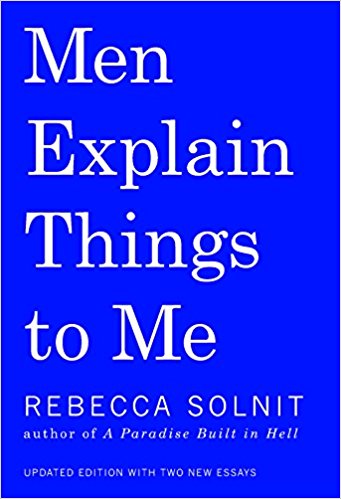
by fljustice | Apr 2, 2018 | Books, non-fiction, Reviews, Wonderful Women
Rebecca Solnit: Two Books for Activists
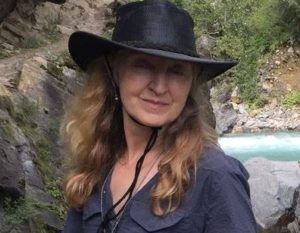
Rebecca Solnit
Coming out of Women’s History Month, I wanted to share with you a women historian, writer and activist I recently discovered. Rebecca Solnit has been active in social justice movements and writing for nearly forty years. How is it that I just found out about her? She’s the author of twenty or so books on feminism, western and indigenous history, popular power, social change and insurrection, wandering and walking, hope and disaster, including the books Hope in the Dark and Men Explain Things to Me. She’s written a trilogy of atlases of American cities; A Paradise Built in Hell: The Extraordinary Communities that Arise in Disaster; A Field Guide to Getting Lost; and River of Shadows, Eadweard Muybridge and the Technological Wild West (for which she received a Guggenheim, the National Book Critics Circle Award in criticism, and the Lannan Literary Award). A product of the California public education system from kindergarten to graduate school, she is a columnist at Harper’s and a regular contributor to the Guardian.
That’s her CV. This is how I finally learned about her. Last winter, Bob Garfield, one of the hosts of the NPR radio show “On the Media” was in such despair after the election that he said during a staff phone call that he had trouble getting out of bed in the morning. One of the other people on the call asked, “Have you heard of Hope in the Dark by Rebecca Solnit?” He hadn’t, but contacted Solnit and had her on his show to talk him down. (You can listen to the segment here.)
This was my first introduction to Solnit and I loved what I heard. I immediately bought her books, which did uplift me, and now I want to share. (more…)
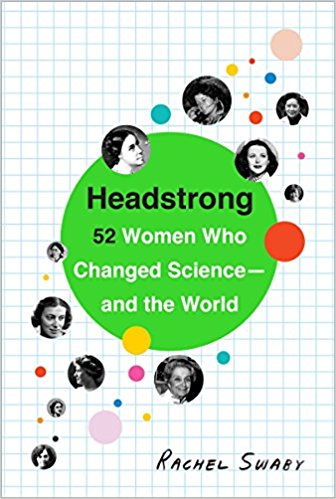
by fljustice | Mar 26, 2018 | Biographies, Books, History, Reviews, Wonderful Women
Exceptional Women in History Part II:
She Captains, Scientists, and Musicians
Last week in Part I, I introduced you to three books of exceptional women in history which primarily covered royals and aristocrats. This week we look more closely at (un)common women in three books. Readers and writers alike will find inspiration here!
She Captains: Heroines and Hellions of the Sea
by Joan Druett
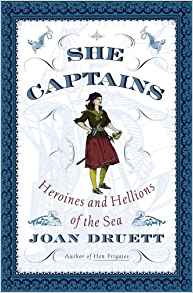
This one sat on my TBR shelf for far too long, but finally got its chance. First of all, I’d say the title is misleading. I expected a book of She Captains to be primarily stories of women who captained ships and lead crews. Druett starts off with 78 pages on ancient queens who sailed with their own navies, female Vikings, and actual female pirates. The rest of the book is devoted to women who are captains’ wives or mistresses, victims of pirates, or involved in the business end. Their stories are fascinating and I enjoyed hearing about them, but that is not what I expected.
The writing is a bit dry and some of the stories seem like padding. I could have done without the chapter on women being captured by Barbary pirates and the space given to Lady Hamilton (Admiral Nelson’s paramour), neither of which seem to fit the premise of the book. What did work was the astonishing number of documented women who went to sea as crew disguised as men; or accompanied their husbands on war ships, whalers, or exploratory expeditions. I had no idea that captains regularly took their wives and children with them on long voyages. I’d always suspected that a number of women made their livings from the sea, especially wives, widows and daughters of seaman, fisherman, and shipping magnates; and was glad to have that confirmed. From the chapter on Ice Queens:
“The winters of the last two decades of the nineteenth century regularly discovered a dozen or more whaling vessels snugged up in Pauline Cove at Herschel Island in the western Arctic, all neatly roofed over and with the sides banked up with blocks of snow. Quite a town would be established around these strange residences, for native, intrigued by the exotic community, build their snow houses near by on the ice. Inside the ships, it was cozy and both inside and outside it was sociable…In the 1894-95 season there where no fewer than seven European females at Herschel Island…It was a strangely formal existence, with dances, whist parties, costume balls, concerts (one concert party being called “The Herschel Island Snowflakes”), and amateur theatricals. Dinner parties were staged, complete with amazing menus. One included “Lobster salad & olives, Oyster Pate with French peas” and “Bartlett Pears, with citron & sponge cake” for dessert.”
The book seems well-researched. Druett doesn’t use footnotes or offer a comprehensive bibliography, but does have a sixteen-page chapter by chapter list of bibliographical notes and a thirteen-page index. I’d recommend this book for anyone who needs to have their consciousness raised about women and the sea (it wasn’t just the boys sailing out there!) It’s the kind of book, that doesn’t quite rate as a research book, but can inspire additional research into the stories of the individual women covered.
(more…)
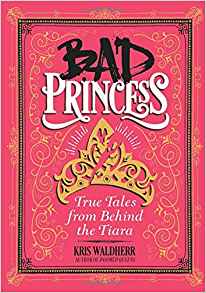
by fljustice | Mar 19, 2018 | Biographies, Books, History, Reviews, Wonderful Women
Exceptional Women in History Part I:
Scandalous Women, Bad Princesses
and Female Kings
It’s Women’s History Month and I thought I’d provide readers and writers alike with some resources on exceptional women in history. I have a soft spot for a particular a kind of history book; collections of short bios of (mostly) unknown women who are remarkable for doing daring/unusual things down through history. They generally follow a pattern of one to five page biographies written in a breezy, modern style emphasizing the outrageousness (for her time) of the woman’s actions.Some of these books are little more than gimmicks or novelty books, best known for their wretched research. Usually there are one or two women that I’ve studied or read about extensively. How accurate the author is with that particular woman is my gauge on how well she’s researched the others.
Why do I like these kinds of books? To be honest, they’re snack food—light fluffy reads that give me a break from heavy turgid research books. They also remind me that—despite what the history books tell us—some women of every age, somewhere in the world were doing remarkable things. The majority (like today) lived ordinary lives, but a few women always stood out and lived extraordinary ones. I like learning about them and being inspired to tell their stories. This kind of book is a good starting point for any historical novelist looking for inspiration. In this post, I’ll do quick reviews of three of my favorites. Next week I’ll do three more. (more…)
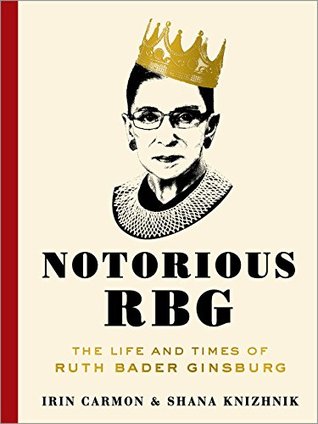
by fljustice | Mar 9, 2018 | Biographies, Books, Reviews, Wonderful Women
Notorious RBG: The Life and Times of Ruth Bader Ginsburg
by Irin Carmon and Shana Knizhnik
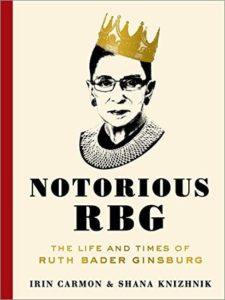 It’s Women’s History Month so here is another entry in books by and/or about women. I’ve been a fan of Ruth Bader Ginsburg since my earliest feminist days. The second woman to join the Supreme Court (appointed by Bill Clinton in 1993), she’s served for twenty-five years as a liberal voice, sometimes shouting into the wilderness; other times changing minds. As the sole women in a tenured position in the Columbia Law School, she co-founded the Woman’s Rights Project at the ACLU in 1971. RGB shepherded some of the most ground-breaking sex discrimination suits through the courts, arguing six cases before the Supreme Court. She won five. She carefully built a foundation of decisions that led to an inevitable conclusion. Discrimination based on gender was unconstitutional. (more…)
It’s Women’s History Month so here is another entry in books by and/or about women. I’ve been a fan of Ruth Bader Ginsburg since my earliest feminist days. The second woman to join the Supreme Court (appointed by Bill Clinton in 1993), she’s served for twenty-five years as a liberal voice, sometimes shouting into the wilderness; other times changing minds. As the sole women in a tenured position in the Columbia Law School, she co-founded the Woman’s Rights Project at the ACLU in 1971. RGB shepherded some of the most ground-breaking sex discrimination suits through the courts, arguing six cases before the Supreme Court. She won five. She carefully built a foundation of decisions that led to an inevitable conclusion. Discrimination based on gender was unconstitutional. (more…)
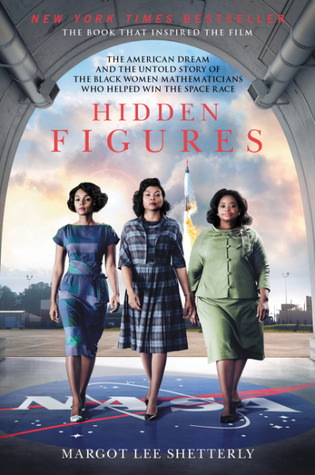
by fljustice | Mar 3, 2018 | Books, History, Reviews, Wonderful Women
Hidden Figures:
The American Dream and the Untold Story of the Black Women Mathematicians Who Helped Win the Space Race
by Margot Lee Shetterly
“Before John Glenn orbited the earth, or Neil Armstrong walked on the moon, a group of dedicated female mathematicians know as “human computers” used pencils, slide rules, and adding machines to calculate the numbers that wo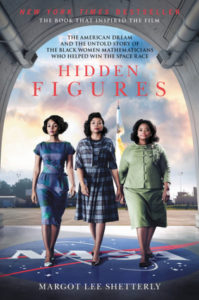 uld launch rockets, and astronauts, into space.
uld launch rockets, and astronauts, into space.
Among these problem-solvers were a group of exceptionally talented African American women. Originally math teachers in the South’s segregated public schools, these gifted professionals answered Uncle Sam’s call during the labor shortages of World War II. With new jobs at the fascinating, high-energy world of the Langley Memorial Aeronautical Laboratory in Hampton, Virginia, they finally had a shot at jobs that would push their skills to the limits.”
Hidden Figures is my transition book from Black History Month to Women’s History Month. It showcases a quartet of significant–but little known–African American women mathematicians. I saw the movie and knew I wanted to read the book. It was obvious that the movie took a lot of “artistic license,” but the underlying story of black women mathematicians at NASA was so compelling, I had to find out the “real” vs. the “reel” of the movie.
Shetterly did not disappoint. (more…)

by fljustice | Apr 2, 2015 | Biographies, Books, History, Reviews, Wonderful Women
Boudica, Queen of the Iceni:
Two books
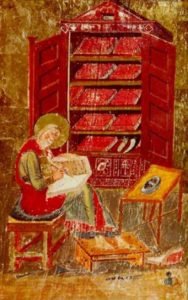 We authors—especially of historical fiction—cannot get along without our research books. (We also like to visit the places we write about, explore museum exhibits, and participate in archaeology and reenactments, but this post will talk about research of the armchair variety.) We prefer primary sources: journals, diaries, letters, histories, account lists, and literature written in the period, describing the people and events we want to write about; but that’s not always possible. For cultures that didn’t have a written language (the Iron Age Celts), or it was indecipherable (Egyptian hieroglyphs until the discovery of the Rosetta stone), or it was destroyed (Mayan books burned by conquering Spaniards); we have to rely on secondary sources. Books, essays, and articles by academics and other professionals in their fields are the best we can do for written research in such cases. But we have to be careful even with those. Just as in evaluating primary sources we have to keep in mind the biases and knowledge of the writer, we have to do the same with secondary sources. Let’s face it, there’s a lot of dreck out there—particularly on the internet—and historical fiction authors usually like to get as close to the truth as possible.
We authors—especially of historical fiction—cannot get along without our research books. (We also like to visit the places we write about, explore museum exhibits, and participate in archaeology and reenactments, but this post will talk about research of the armchair variety.) We prefer primary sources: journals, diaries, letters, histories, account lists, and literature written in the period, describing the people and events we want to write about; but that’s not always possible. For cultures that didn’t have a written language (the Iron Age Celts), or it was indecipherable (Egyptian hieroglyphs until the discovery of the Rosetta stone), or it was destroyed (Mayan books burned by conquering Spaniards); we have to rely on secondary sources. Books, essays, and articles by academics and other professionals in their fields are the best we can do for written research in such cases. But we have to be careful even with those. Just as in evaluating primary sources we have to keep in mind the biases and knowledge of the writer, we have to do the same with secondary sources. Let’s face it, there’s a lot of dreck out there—particularly on the internet—and historical fiction authors usually like to get as close to the truth as possible.
In researching Sword of the Gladiatix, I collected several books, articles, and pamphlets on Boudica and Roman Britain, most of an academic nature, a few of the more “popular” variety. The two biographies of Boudica I review below are the best by far of both types. You can read either or both and get a well-researched, readable history of the Iceni Queen, her times, and her legacy in popular culture. Which to read depends on your needs and nature. (more…)










